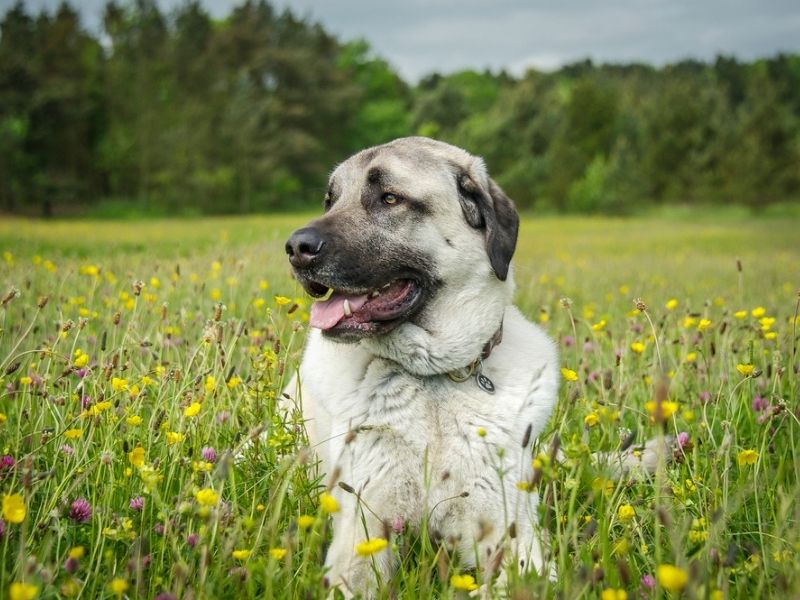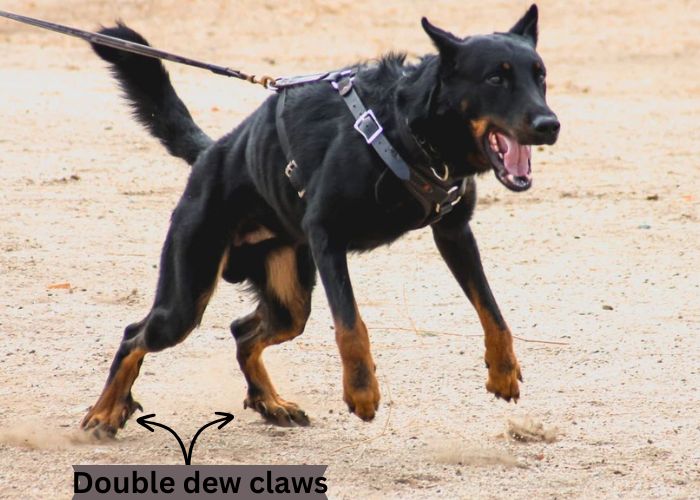Dog breeds with double dewclaws include purebred dogs such as the Great Pyrenees, Catalan sheepdog, Briard, Beauceron, and Anatolian shepherd. As seen, generally dogs that have double dewclaws are large breeds.
What are double dew claws for?
Double dewclaws are primarily for large dog breeds or even small dogs to achieve extra balance and steadiness. Basically, with double declaws on hind legs, your dog breed benefits from having an additional thumb and support.
Therefore, unlike small dogs, the large breeds with double dewclaws can firmly grip the ground while running, pulling, or digging as guarding and working dogs. The double dewclaws are also useful in grasping and manipulating different items such as toys and bones.

5 Dog Breeds with Double Dew Claws
Double dewclaws are commonly found in purebred dog breeds. However, some breeders choose to create a mix just to achieve a dog that has dew claws on the rear or front legs of the dog.
Here are 5 common dog breeds with double dewclaws:
1. Anatolian shepherd

Also known as the Kangal, the lineage of this dog breed with double dewclaws can be traced back to the Bronze Age. It may have been bred from two war dogs, which are the Roman Molossian and Tibetan Mastiff native to Turkey.
The Kangal came in handy for safeguarding livestock against predators such as bears, wild dogs, and wolves. And since the dogs used to go wherever their nomadic shepherds went, with time the dog breed became available in different geographical locations.
That is the main reason why the Anatolian Shepherd is varied in size, type of coat, and even color. Still, a trait that endures is that the breeds are loyal, independent, and hardy.
In America, the first Anatolian Shepherd was seen around the 1950s and used for protecting livestock against different predators including coyotes.
Around the 1980s, appreciation of the breed skyrocketed, leading to its acceptance in 1996 into the American Kennel Club Working Group.
| Weight | 110-140 pounds (Male); 90-130 pounds (Female) |
| Height | 29-31 inches (Male and Female) |
| Coat color | Red fawn, blue fawn, brindle, and white Liver |
| Lifespan | 11–13 years |
| Temperament | Laidback, protective |
| Origin | Turkey |
| Family | Mastiff; Roman Molossian |
| Hypoallergenic | No |
| Dewclaws | Double |
2. The Great Pyrenees

It was bred centuries ago and exists as a descendant of the first livestock guardian dogs. The ancestors of this dog breed with double dewclaws used to roam Asia Manor around 10,000 B.C.
About 3000 B.C, nomadic shepherds came with the livestock guarding dogs in the Pyrenees Mountains. That led to the starting of the Great Pyrenees breed.
Initially, the breed only served in medieval France for centuries as a livestock guardian. But, later it got adopted as a guard in the French royal courts and used by nobles for guarding the often sizeable chateaus.
In America, due to importation, huge numbers of the Great Pyrenees started to be seen around the early 1930s. With its subsequent recognition by the AKC, the breed over the years has managed to garner a lot of attention as a furry friend and a reputable livestock guardian in the USA.
| Weight | 100 pounds and above (male); 85 pounds and above (female) |
| Height | 27-32 inches (male); 25-29 inches (female) |
| Coat color | White or white with patches of brown or gray |
| Lifespan | 10-12 years |
| Temperament | Devoted to family and cautious about strangers while being independent |
| Origin | France |
| Family | Flock guardian dogs |
| Hypoallergenic | No |
| Dewclaws | Double |
3. Briard

Known in France as the Chien Berger de Brie, this breed with double dewclaws is a native of the dairy-producing region in the north. The family dog was bred and reared for livestock guarding and herding.
With a strong instinct and cautious approach to strangers, the Briard is known to have been owned by famous people such as Lafayette, Emperor Charlemagne, and Napolean.
Even, the third U.S. president who was a known hater of dogs fell in love with the Briard. Being one of the authors of the USA Declaration of Independence, he received the breed for livestock guarding at his estate as a gift from Lafayette, a comrade, and friend.
As one of the large breeds, the dog is very active, requires lots of physical activity, which it is suited for since there are dewclaws on hind legs. Remember that a bored family dog will engage in activities that are destructive like digging.
The Briard is not a great kennel dog since it prefers to always be with its owner.
| Weight | Male: 60-100 lbs; Female: 50-80 lbs. |
| Height | 23-27 inches (male); 22-25.5 inches (female) |
| Coat color | All uniform colors excluding white |
| Lifespan | 10-12 years |
| Temperament | Fearless, loyal, intelligent, protective |
| Origin | France |
| Family | Beauceron |
| Hypoallergenic | No |
| Declaws | Double |
4. Catalan sheepdog

The breed originated from the Spanish region of North Eastern. Not being one of the small dogs, the dog breed was raised to assist farmers to safeguard their livestock during the Middle Ages. It has a double coat to guard it against punishing weather conditions.
During the Spanish Civil War and World War 1 and 2, the Gos datura Català found itself useful as a messenger. Its declaws on the back and front legs proved useful in giving its stability and balance to perform its tasks.
Having avoided potential extinction in its native land in the 1970s, the breed currently serves as a popular family member. The dog breed is mild-mannered, intelligent, and instinctively programmed to protect its owner and home.
| Weight | 44-55 pounds (Male); 37-46 pounds (Female) |
| Height | 18-22 inches (Male); 17-21 inches (Female) |
| Coat color | Brown, red, grey and black, black and tan, grey and white, etc. |
| Lifespan | Over 10 years |
| Temperament | Intelligent, protective, gentle, and devoted |
| Origin | Spain |
| Family | Bergamasco, Bearded Collie, and Basque Shepherd Dog, |
| Hypoallergenic | No |
| Dewclaws | Double |
5. Norwegian Lundehund

Apart from having double dewclaws, the Norwegian Lundehund is a special addition here since every paw has six toes. That trait enabled the dog breed to have even more sufficient traction on the rocky slopes and islands of the Lofoten as it hunted puffin.
In Norwegian the term ‘Lunde’ actually means puffin. The pelagic seabirds served as a source of food for the dog and farmers residing on the islands.
Using their flexible shoulder joints and necks, the dogs found it easy to climb cliffs and squeeze into channels to catch seabirds and their eggs in nesting areas not easily reachable.
At the beginning of the 20th century, the breed faced potential extinction due to taxes levied on ownership and excess catching of puffin. Luckily, on Vaeroy, a couple of purebred dogs managed to be retained before being subjected to a breeding program to save its population.
| Weight | 20-30 lbs |
| Height | 13-15 inches (male); 12-14 inches (female) |
| Coat color | Brown, grey, yellow, red, black, white, and tan |
| Lifespan | 12-14 years |
| Temperament | Energetic, loyal, protective, and alert |
| Origin | Norway |
| Family | Spitz |
| Hypoallergenic | No |
| Dewclaws | Double |
What causes double dewclaws in dogs?

The cause of double dewclaws in dogs is related to different genetic mechanisms. There is the involvement of the non-sex-linked recessive gene and LMBR1 Gene, a limb development membrane protein, and the associated genome parts.
Are double dew claws bad?
Double dewclaws are not bad for dogs. Particularly, large breeds need the double dewclaws for attaining the maximum possible stability and gripping power while performing different activities. However, small dogs may not need the extra thumbs to operate efficiently.
A potential disadvantage of having double dewclaws is that when left to grow longer, they can get torn and entangled on things like fabrics. Moreover, when the dewclaws on hind legs or rear legs grow longer back into the dog’s pad, that can be very painful to your furry friend.
In conclusion, thus, ensure double dews are regularly trimmed and tight to the dog’s paw. If the appendages are connected to the leg of your canine friend via bone and sinew, avoid removing them. Removing the extra thumbs can be excruciatingly painful and damaging, especially for working, large breeds. In small dogs though, the double dewclaws may require removal.